Gigabyte Sabre 15-K Review
Gigabyte Sabre 15-K
A solid mid-range gamer for £1149
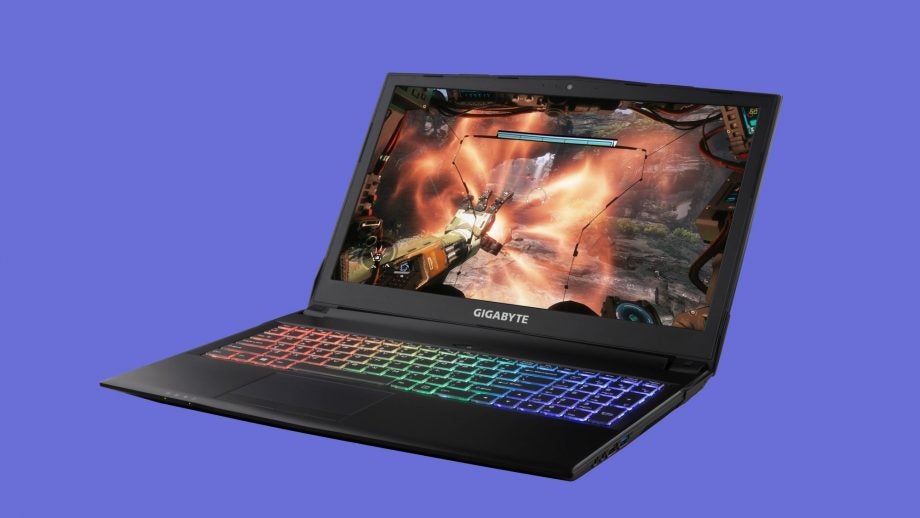
Sections
- Page 1 Gigabyte Sabre 15-K Review
- Page 2 Performance and battery lfie Review
Verdict
Pros
- Fast in 1080p games
- Better screen quality than rivals
- RGB keyboard backlight
- Slick design
Cons
- Small SSD
- Underwhelming battery life
- Middling keyboard
- Weedy speakers
Key Specifications
- Review Price: £1149.00
- 2.8GHz Intel Core i7-7700HQ processor
- Nvidia GeForce GTX 1050 Ti 4GB graphics
- 15.6in 1920 x 1080 IPS screen
- 8GB 2400Hz DDR4 memory
- 128GB Transcend MTS800 SSD
- 1TB hard disk
- Windows 10 64-bit
- 2yr RTB warranty
What is the Gigabyte Sabre 15-K?
The Gigabyte Sabre 15 is the latest gaming laptop to use the Nvidia GeForce GTX 1050 Ti graphics core – the ideal GPU for eSports and playing AAA games at Medium settings.
This £1149 system squares up to the Dell Inspiron 15 7000 Gaming, which is a mainstream favourite costing £50 less than the Sabre.
Related: Best gaming laptops
Gigabyte Sabre 15-K – Design
Many recent gaming laptops fall into one of two camps: some offer outlandish design, while others opt for more subtle styling. The The Sabre 15-k is firmly in the latter camp.
The lid is decorated with a simple Gigabyte logo and two subtle slashes in matte aluminium ,and the back has angled air vents. The diamond-shaped power button sits above the keyboard and at the centre of an elegant curve, and the keyboard has RGB backlighting that’s set to a cool blue by default.
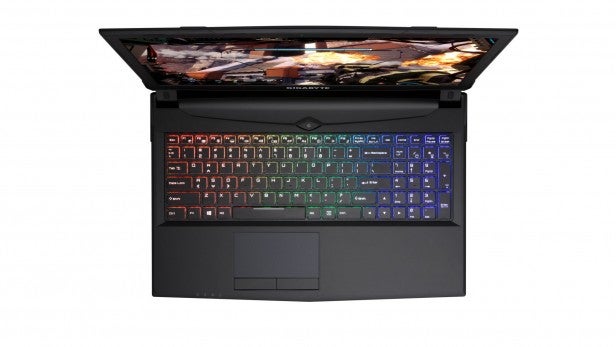
Dell’s machine looks louder thanks to its red accents and dramatic rear vents, but the Gigabyte is subtle and smart – it’s an attractive laptop that holds its own against the the Inspiron 15 7000 Gaming.
It competes well on the scales, too. Its 2.5kg weight makes it 150g lighter than Dell’s effort, and its 27mm body is only 2mm thicker. Those aren’t margins that you’ll notice in daily life, and it means that this machine is easy enough to sling into a bag.
The battery is removable, and Gigabyte has no problem with people removing the base panel to get tinkering. There’s a single memory slot free, and the storage and cooling gear is accessible.
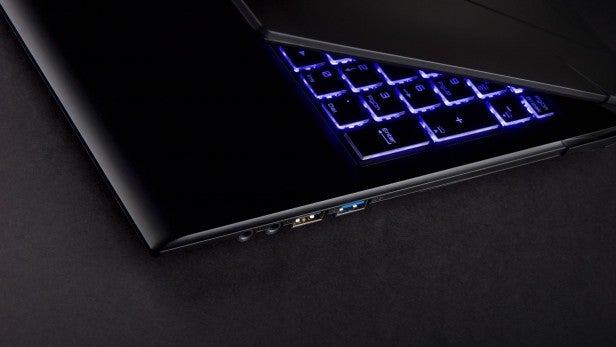
The interior serves up dual-band 802.11ac Wi-Fi and Gigabit Ethernet, and the Gigabyte’s edges have USB 3.1 Type-C and USB 3 ports, mini-DisplayPort an SD card slot – so this machine is set up for modern peripherals, multi-monitor setups and more.
Gigabyte Sabre 15-K – Screen and audio
The Gigabyte has a Full HD IPS screen with a matte finish, and it provides better viewing angles than the Dell could manage. It delivers good uniformity, too, with the screen’s brightness consistent across all areas.
In other benchmarks the Sabre 15-K is more mediocre, although it’s still better than the Dell in key areas. Its contrast ratio of 652:1 is nothing special, for instance, but it easily beats the woeful 363:1 delivered by the Inspiron 15 7000 Gaming’s TN panel. The overall experience is a fair way better than what you’ll find on Dell’s laptop.
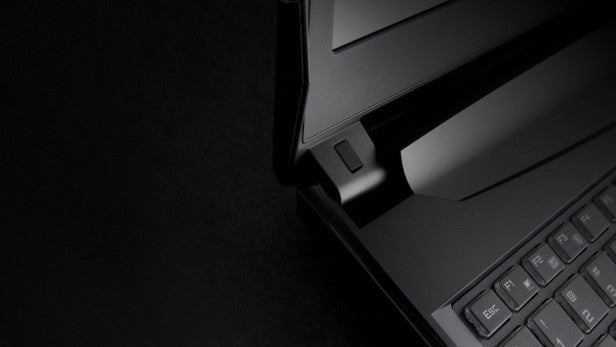
It also has a reasonable black level of 0.38 nits, which means that darker areas in games will have suitable depth.
The Sabre’s colour temperature of 8111K (closer to 6700K is better) is too chilly, though, and its Delta E of 5.48 (close to zero is better for colour accurary) is average. The Sabre could also render only 55% of the sRGB colour gamut, which is on a par with the Dell’s 58% figure. As a result, this machine will display only a relatively narrow range of colours.
Gigabyte’s machine has the usual gamung laptop audio kit, with a pair of 2W speakers but no subwoofer. It’s all managed by Creative’s Sound Blaster Cinema 3 app, but the sound kit here doesn’t throw up any surprises.
The default Music mode serves up bright, precise audio that’s undermined by vocals that are too echoey and distant – and the lack of bass means that music and games lack depth. The Movie option turns up the vocal enhancements, which helps, but it offers only a minor improvement; Gaming mode offers virtually identical output.
The Gigabyte’s speakers pair their delicate output with a lack of volume that’s fine for close-quarters gaming but not ideal for sitting further away for gameplay or movies.
This machine doesn’t suffer poor audio, it’s just too weak in terms of quality and volume when compared to the Dell – I recommend using a headset or some external speakers.
Related: Best Gaming Headsets
Gigabyte Sabre 15-K – Keyboard and touchpad
Gigabyte has made sure that the Sabre’s keyboard is packed with features. It has a numberpad, just like the Dell Inspiron 15 7000 Gaming, and it goes beyond the Inspiron in several areas.
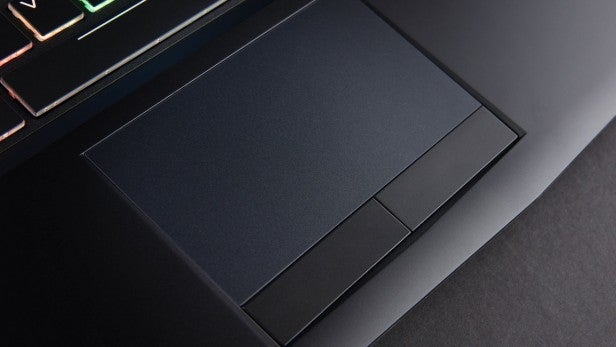
For starters, there’s the ‘Flexikey’ software, which introduces macro recording and hotkey configuration – additions that I usually see on mechanical keyboards rather than laptops. Multiple profiles can be supported, too, which is ideal for switching between games.
The Flexikey software works with the trackpad, too. Keyboard buttons can be assigned to mimic a mouse wheel and two shoulder buttons. Its final trick is RGB backlighting – another feature that Dell doesn’t offer. It can be configured in the Flexikey software with the usual range of solid and patterned colour settings.
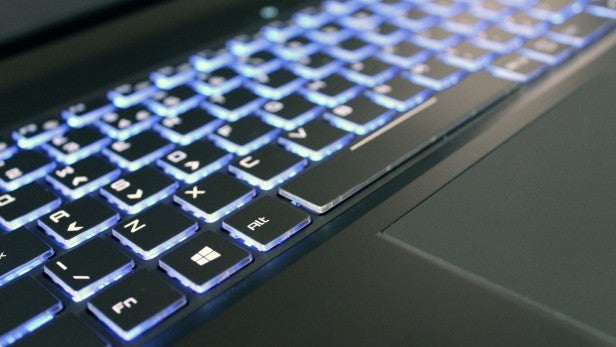
But the Gigabyte’s keyboard and trackpad are more ordinary in actual use. The buttons are soft, comfortable and offer reasonable speed, but the Dell’s keyboard is snappier – which makes it a little better for gaming.
The trackpad, meanwhile, has a solid surface and two buttons that do a fine job of providing a short, snappy click.
How we test laptops
Unlike other sites, we test every laptop we review thoroughly over an extended period of time. We use industry standard tests to compare features properly. We’ll always tell you what we find. We never, ever, accept money to review a product.


